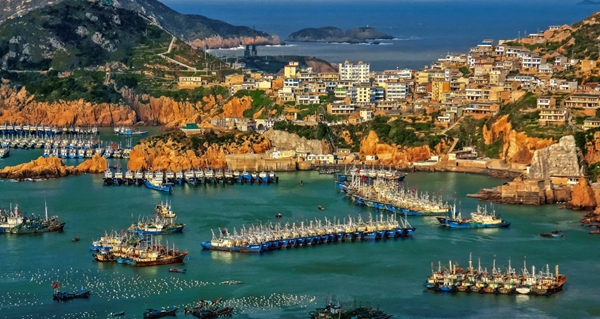This is Zhoushan

Shengshan Island in Zhoushan, East China's Zhejiang province [Photo provided to chinadaily.com.cn]
Population: 1,173,000 permanent residents (2018)
Area: 22,200 square kilometers (20,800 square kilometers maritime area and 1,458.76 square kilometers land area)
Location: northeastern part of Zhejiang province, and juncture of Gold Coastline and Yangtze Golden Waterway in eastern China
Economy:
Zhoushan is a major coastal open city. The total value of its imports and exports rose by 44.9 percent to 113.55 billion yuan ($16.45 billion) in 2018. It is a major exporter of aquatic products, food, textiles and industrial products.
In 2018, Zhoushan recorded a GDP of 131.67 billion yuan, a year-on-year increase of 6.7 percent. The added value of its primary industry was 14.26 billion yuan, increasing by 5.8 percent; its secondary industry was 42.84 billion yuan, rising by 6 percent and its tertiary industry reached 74.57 billion yuan, growing by 7.2 percent over the figure for 2017. The 112,490 yuan of per capita GDP in 2018 was 6.0 percent higher than that of 2017.
Administrative divisions:
Zhoushan administers two districts and two counties, namely the Dinghai district, Putuo district, Daishan county, and Shengsi county. The city currently consists of 17 towns, 14 sub-districts, five townships, 116 neighborhood communities and 296 administrative villages (2017).
Brief introduction:
Zhoushan is located in the Zhoushan Islands, Zhejiang province. It is backed by large-and-medium-sized cities like Shanghai, Hangzhou, Ningbo, and the vast hinterland including the Yangtze River Delta. Facing the Pacific Ocean, Zhoushan owns a strong geographical advantage. It is an intersection hub between national north-south coasting shipping lines and the Yangtze River waterway, a seaside gateway and a channel for opening of the Yangtze River areas and the Yangtze River Delta, and it fans out to Asia Pacific emerging port cities.
The Zhoushan Islands have a long history. According to archaeological discoveries, as early as the Neolithic Age, 5,000 years ago, there were people living on them. In the relics of Maao Town, located in the northwest of the Zhoushan Islands, aboriginals built 99 earth mounds by the sea and created the mysterious and brilliant "Hemudu Culture of Sea Islands". Maao Town is thus known as the "First Village in the East China Sea".
